European Letters, by T.W. Patton to
The Asheville Citizen:
Description of the Tour of
the North Carolina Teachers, During the Summer of 1889
LE GRAND PARIS. [pages 54-64] |
|
*Note: Copy has been re-formatted. Original two column format has been
abandoned and special fonts have been standardized.
|
| Pages # |
I.D.# |
Description |
Thumbnail |
| |
eur054 |
LA GRAND PARIS
PARIS,
August 32, 1889.
dear citizkn:—-"Je
desire que mes cindres
reposent sur Ics bordes de la Seine, au
melieu de ce peuple Francais que j'ai taut aime."
To-day we read these last wishes of one
of
the world's grandest men, as we stood
within n few feet of his mortal remains, resting as he desired, on the
banks of the
beautiful Seine, and surrounded by every
evidence that the. French people loved him
whether his professed love for them was sincere or not.
The tomb of Napoleon is in all respects
appropriate to be the resting place of the great general. Its brightly,
gilded dome
flashes in the sunlight, as though to commemorate
the splendor of his wonderful achievements, while the somber colored
marble of which the mausoleum is composed
exemplifies the sad ending of a life,
in
exile, far away from his home and his
people. .
We could not but ask
ourselves, how many of the thousands
who flock to this spot and gaze down at all that is left of
Napoleon Bonaparte reflect that this is but a sermon on the text of King
Solomon, "All is vanity."
For
the past fortnight we have enjoyed
the most marvelous works of God, as seen
in
the mighty snow capped Alps, overlooking
the calm peaceful lakes at their feet.
To-day we have been engaged in the
consideration of the most
beautiful works of man, as they .abound on all sides of this, the most
beautiful city of the world.
Although we have all heard
Paris so described again and again, it is impossible
to realize its exquisite beauty short of a personal visit. One is
impressed by this upon first arrival—there seem no "slums" to
.greet the traveler, such as usually abound near the railroad stations. Even the older portions of the city are made of well built
houses, while the
newer parts we do not think can elsewhere
be equaled.
We
cannot tell the impression the Tuilleries
might have made upon our mind
could we have seen them, but what is
left, the Louvre, in all of its mighty expanse
of building, fills us with amazement
nearly approaching a we and teaches
us how little we knew when
we used to think that our public
buildings iri Washington were marvels in architecture..
For
a description of this palace of marvelous
beauty we are at a loss at what point to begin. Naturally we are
disposed to enter into statistics, so many
feet or meters, but that would never
satisfy us, and how could it
you ? While it is surely the
largest building we ever saw, it size is a secondary thought. Its
admirable proportions seem to draw
every part near to the
beholder, and the distant statuary seems just at hand, but
when approached by many hundreds of
paces, the perfections in detail of each
piece are brought to view, one begins
to realize the marvelous skill
of the designer.
The beautiful gardens which now take
the
place of the Tuilleries, which the Commune destroyed, make a lovely foreground
to the magnificent rectangle of which three sides remain perfect, and
extend to Le Place de Concorde, once
the site of the dreadful
guillotine, of which the exact
spot is marked by an Egyptian obelisk, not so large as ours in
Central Park, but much better preserved, as to its hieroglyphics, and
equally out of place, as we think, in
its present position.
These works of antiquity would possess
great interest, if restored to their
original pedestals, .and would there be
visited by scholars, who would
appreciate them, but here as
in New. York, a gaping crowd, of whom we: are one, surround
them, and their, flimsy jokes seem
almost sacrilege. Surely some
more suitable work could be
suggested to preserve the
|
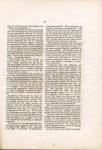 |
| |
eur055 |
spot on which the poor Queen Marie Antoinette
was murdered.
It
is curious what an effect is produced
upon the imagination as one stands upon
the
very spot made famous by history
nnd. fiction. Perhaps we had not thought of "The Tale of Two Cities" for
months,
and yet as we stood>at this place we fancied
we could hear the roll
-of
tumbrills
and see brave Carton descend,
holding fast the hand of his
poorlittlecompanion and
offering her comfort to the very last,
and then stepping forward to give his
life for that of his
sweetheart's husband, and
Madame Befarge's companions counting the guillotine's fall as they did
their knitting, "Twenty-one!
twenty-two! twenty-three
! Vive la Republique !
These French are curious
people. In the eyes of the women one
can see the spirit
which produced the Revolution
and the horrible Commune, while
acrovvd of urchins follow our
carriage for squares crying aloud "Vivc L'Anfflais," in
hopes that an American may reward their patriotism
with a centime.
If
the French people do not impress us
favorably, we must accord them the
just
praise of having produced the most wonr
derfully beautiful buildings. We have this
moment emerged from Notre Dame and
are full of its grandeur, so full is our
weak brain, that we in
vain try to write our thoughts. We can only say that we
feel not the oppression which
attended our visit to
Westminster Abbey, but have
sensations of delight, although inexplicable.
An ascent of the tower is
made by climbing three hundred and
seventy-eight steps of stone, and in places they are as dark as
Egypt, but the view obtained from
the top amply repays the
fatigue. The most attractive to us is the
graceful curve of the flying.
buttresses, rising from cither
side to support the ponderous
roof of the nave. To see these
to advantage one must look down from
above, as otherwise only one
side can be seen at a time, but from the tower both sides are
taken in at a glance, and the tout
ensemble is wonderfully, exquisitely
beautiful.
The
whole
city,
too, is spread out below
us and we see no cause to climb the
dizzy height of the Eiffel
Tower, although it is indeed a
wonderful exemplification
of engineering skill. The panorama as
we
have just seen it.is truly lovely. The
bright silvery waters of the Seine
divide
to
take, as it were, this grand old church
into
its
arms, and reunite above and below
the island on which it is .located,
while .beyond its line the Hotel de
Ville is seen, around which
we have just driven, amazed at its wondrous loveliness.
The number of statues, and
paintings is absolutely bewildering,
and not being educated in an admiration of high art
we must confess to feeling sometimes
an intense weariness. Thus
to-day we were glad to leave
the gallery of the Palace de
Luxembourg, where the highest art prevailed, adorned in all its
nakedness, and to revel in real enjoyment" in its lovely
garden, where sweet flowers seemed
to
raise men's minds to thoughts
of innocence and
purity.
Among the many fine buildings
.
we
have seen two that are especially worthy
of
note are the church of St. Sulpice and
the Pantheon. The latter
contains the tomb of Victor, Hugo,
and is said to be a good copy
of the grand Pantheon in
Rome. The interior comprising several
domes, of which the centre seems
equal to that of our national
capitol, is especially
impressive, while the church was
most attractive, differing
from any we have heretofore
seen, all of its paintings
being of a most rich, but
sombre [sic] character. We especially note that of the
blessed Virgin and child, its peculiar
light making it. appear far, far distant
in its softness. The bronzes of the
stations, of the cross, were
also most interesting and
impressive (fourteen in number)
nor can we neglect to mention the
wall painting of the dread scene on
Calvary "Jesus dit, tout est accompli."
What swarms of Americans
on every hand. Is any one left
at home ? On yesterday, we
tried one of Cook's city
tours, and in our carriage
holding thirty-five people
twenty-five were our countrymen.
This tour was well
arranged and gave a good idea of the geography of the city, so that we
can manage for ourselves in future.
A competent guide accompanied the party, and among other points
of interest, visited the old cemetery
of Pere La Chaise, where we saw the
tombs of many illustrious men.
As our attention was
called to the sup- ...
|
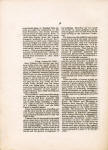 |
| |
eur056 |
... -posed burial place of
Marshal Ney, we could not resist the temptation to tell these Frenchmen,
that North Carolina h as the honor
of being the last home of the great soldier, who lived there many
years after haying given the famous command "soldiers at my
heart, fire;" in obedience to which
only a discharge of blank cartridges was made, and a bogus
Ney being buried, the real one was
safely transported across the
Atlantic, to become an old school teacher in Rowan
county. This un-poetical suggestion
did not seem to find much
favor among our audience, so we did not press our point, but left
these Frenchers to their idols.
Good
bye.
_________
paris,
August 25, 1889.
Dear Citizen:—The weather
has been most unlike what one would expect in
sunny France—very variable, showers of
rain, and uncomfortably cool. So when
we, in company with ten thousand other
idiots, on yesterday ascended the
famous Eiffel Tower we were
quite satisfied with our
experiment upon Teaching the second Etngc, or about half
way up, and found that it could rain there quite as hard as any place we
ever saw, while the floor was so badly drained that the water stood two
inches deep. Owing to the crowd we
could neither go up nor down, and never remember to have passed a
longer half hour than while a
waiting our turn to descend.
This is indeed a most marvelous structure,
and one appreciates its immensity best, at the first floor, probably 350
feet above the ground, where is found
quite a little village, including a
restaurant, while on the
next, or 600 feet high, is a publishing house, and the Daily
Figaro is regularly issued.
Under the circumstances attending our
visit the view was by no means satisfactory,
and we regretted having wavered in our original intention not to visit
the Eiffel Tower.
A
second day at the exposition grounds
gives a much more favorable impression
than was gained at first, but yet we think
that in some respects it
falls far short of that at Philadelphia. So far as we have
been able to see the grounds do not
at all compare in beauty with
ours, nor do we like so well the general arrangement of
the buildings. Here they
are too much sub-divided by small
galleries, and we miss the
grand view we had of the whole
main building at the American
Centennial.
The dome over the chief entrance comes
nearest to it and is the
most attractive portion, both on its
own account and because
ornamented with the wonderful tapestries that are made here. It
is indeed hard to conceive how these
can be the product of looms.
They look so like the very
best oil paintings. Even the perspective
is admirably preserved, and
landscapes, flowers, birds, animals, portraits and statuary are
reproduced in a manner marvelously
natural.
So
far as we have yet extended our inspection,
we give the palm to Russia as
having the best exhibit,
especially attractive in its assortment of silks, malachite and furs,
the latter particularly comforting this cold day; while those
from Norway are well selected and
most tastefully arranged,
comprising several grottoes,
showing in natural size the various
animals and birds of that northern
clime.
France's exhibit, of course, is most extensive,
and we note some wonderful productions
of glass, especially a ball of material
for watch crystals, as clear as a soap bubble, but six feet in diameter.
Also a pane so absolutely transparent that we attempted to walk through
it, measuring twenty-six feet high
and fourteen feet wide and
weighing about 2,000 pounds.
Outside of the mechanical department
the
United States seem very poorly represented.
Mr. Edison and Thompson &
Houston have marvels of electricity.
The phonograph of the
former and the welding machine of the latter are both
miracles. We cannot yet see much
practical good of the
phonograph. Its sound, while distinct, is distinctly mechanical,
with a brassy effect that is
disagreeable. But the welding machine is destined to
revolutionize mechanical works. Only
reflect that we saw two pieces of iron
two inches in diameter, in less than
one minute welded as fast as if it had never
been severed, and without the
expenditure of a particle of
heat or labor beyond what was, needed to place it in the machine. |
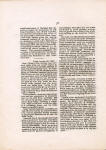 |
| |
eur057 |
Tiffany & Co. seem to have tried to redeem
the character of America, and present
a very creditable display in silverware and gems. Among the latter we
were glad to see several specimens
labeled as from North
Carolina, and the counties of
McDowell, Alexander, Mitchell, Ashe,
Macon and Clay are conspicuously
represented.
This is our first Sunday
in Paris, and we
decided to attend service at the
Russian church, which proved most attractive, both from the
novelty and the great solemnity which attended it throughout. It seemed
very strange to be in a church
without chairs or any kind of seats. The congregation stood
during the service, which only extended over an hour's time. The singing was
exquisitely sweet and the intoning of the gospel by the priest
was exceedingly impressive. The
congregation took no part in
the service farther than by
very frequent bowings and crossings on the breast. In fact, every
one except ourselves seemed to be
doing this almost
continually. The vestments of the priests were extremely rich,
being chiefly made of silk and gold.
Altogether it was a service to be remembered for its
impressiveness, although performed
in a language of which we could not understand
a single syllable.
Our next mortification of
the spirit, is to visit the Louvre, and its stupendous
galleries of paintings. Oh! how we
long to be able to appreciate these things, but we cannot and it
is useless to try any longer. If it were not for the high art we might
stand it, and in time learn to enjoy
it, but the naked men and women, which the lovers of art stand
before in rapture, become to us
perfectly, absolutely
monotonous, wearisome and disgusting. We know this is heresy, but candor
compels us to acknowledge it.
So even the magnificent rooms
of this grand palace are
quickly left for more congenial
scenes, which we find by a walk
through the gardens of the
Tuilleries, and passed the
lovely fountains of the Place de Concorde. Thence a cab carries
us along that truly royal drive, the
Champs Elysees, which brings us to the arch of
Triumph, which we stop to examine
and to admire, commemorating as it does
the wonderful victories of the first
Napoleon.
And so on we drive to and through
the
Bois de Bolougne.
In this latter we are
somewhat disappointed ; while very
beautiful in some respects,
the trees and undergrowth are allowed to be too thick, keeping
out the sunlight and giving to all a damp, dark
appearance. On the whole we do not
like it half so well as our Central Park.
The best part of the Bois de Bolougne,
is Le Jardin
d'Acclimation which is
filled with most lovely bright flowers,
among which ramble many excellent
specimens of rare birds and animals. The
flock of ostriches is the best we have ever
seen, and one of them affords delight to
the children by drawing
them in a cart over the smooth walk.
We
think these specimens far better than any we saw in the Bi-itish
Zoological
garden. In fact we find ourselves
often comparing our impressions of London
with those of Paris, and decide that
in
each and every respect the latter is by
far the most attractive
and agreeable city, although we wish
they would adopt a different style of cooking and arrangement
of meals. What they call un petit
dejeuner
would make about one mouthful for one of our robust mountaineers,
and when we are so utterly exhausted
as to seek a drirk of cognac,
our host presents us a glass about the size of an infant's
thimble, and would be utterly horrified
if we fill it more than once, while
the flavor of the liqueur is such as
to impress upon us how
absolute!}' absurd such a measure is, and to make us look
forward anxiously to our return to
America, and our friend Loughran and
others.
The water of Paris is so
horribly bad that no one pretends to touch it; but
they drink wine instead, and that so terribly sour that our pigs
would raise an uproar of squealing
if compelled to taste it. Maybe we will come to like it after a
while, but we scarcely think it will
be worth the effort, therefore will not try
any longer but stop right now.
paris,
August 28,1889.
Dear Citizen:—We think the
best way
to enjoy a city like this is to ramble
around its streets without having any plan marked out for one's
movements.
|
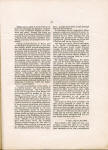 |
| |
eur058 |
Everything is strange and new, and objects
of special interest arise unexpectedly
at
each step. Of course, to follow this
suggestion one must be strong and well,
and fond of walking, because the
distances
are immense.
A
stroll on yesterday began at the Grand Opera house, well named even in
the English sense of the word grand. In
Paris everything is
"grand." Our landlady advertises "Grand Apartments to Let," and yet
when we asked the chambermaid for a
match she replied with amazement, "Madamc ne fournis point
Ics allumettes."
But the opera -house is grand in the strongest sense of the word, and
such grand prices
prevail that we can only speak of the exterior; but that is truly
beautiful and located at the junction of
several principal avenues, so
astoappear to the very^ best
advantage. A half hour is well spent in walking around and admiring
it.
THE BOURSE.
Friends, have you ever visited the New
York Stock Exchange in the
busiest sea" son ? We have, and the
scenes there are as the stillness of the tomb compared to
what prevailed in the Bourse. Ten
thousand Frenchmen, chattering, screaming, pulling, yelling,
gesticulating, as only a Frenchman can, made a bedlam that Old
Nick himself might envy, but never
equal. If the amount of money made corresponded with the fuss
they must be rich indeed. There being no objection made to strangers
entering the principal room we did
so, and enjoyed for a few moments the tremendous turmoil all
around us.
THE PALAIS ROYAL,
We are told, used to be
the residence ot some one of the old kings, no doubt one of the Louis,
whose name is legion, but now has
degenerated into magnificent arcades of shops. The building
comprises a rectangle, enclosing a
space of probably ten acres, which is adorned with flowers
and fountains, while surrounded by
innumerable shops,
principally devoted to the sale of jewelry. Their many windows
fairly flash with diamonds.
THE LOUVRE.
Our aimless walk taking us
past this glorious building, we stop again and again to gaze in wonder
at the achieve-
ments of art which so
beautify its exterior, and to wish again and again that a
cut could be had to give your
readers an idea of its appearance. Without taking
measurements we would say that when
the Tuilleries were here the
buildingmust have extended
well nigh a half mile from east to west, with an average breadth
of 600 feet. These dimensions we
intend to include the space
enclosed within the buildings, probably amounting to thirty
acres, which contain now among many
statues one most remarkable to Gam-betta, and an arch, similar
but smaller to Napoleon's "Arch de
Triomphe," called "La Place
de Carousel."
Remember that this space
which we estimate roughly at thirty
acres is inside of the buildings which formerly entirely surrounded it,
but now, the Tuilleries being
destroyed, only the three sides remain.
Both the inner walls,
facing upon this enclosed space, and the outer, fronting
the streets, are almost covered from
end to end with statuary and carvings in
stone, while the very rocks of which
they are built are worked in
delicate traceries from top to bottom, from end to end,
from side to side. We wish we could
imagine the cost of this work. If as a basis
of calculation we take the
foundation of our Episcopal church, your whole four
pages would be covered with figures.
The interior is no less msirvelous than
the outside, and one is wearied in walking
up and down the tremendous galleries
covered from floor to ceiling with paintings
bv the most renowned masters,
while others are devoted to historic specimens, among them several
crowns blazing
with jewels, and a sword the whole
hilt of which is one mass of diamonds.
Passing once more through the beautiful
gardens which are an appropriate monument to the grand palace of the
Tuilleries, and looking again at the
lovely fountains of the Place de Concorde, we find ourselves near
the Church of St. Magdalene, and at its entrance have a
pleasant greeting from Mrs. Frank Coxe and daughter, whom we last
met in Queen Mary's chamber
at Edinburg. How sweet it is to have such meetings
with kind friends just as one is
beginning to feel lonesome, as though he were the only person in
this vast throng who ...
|
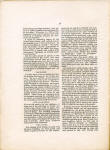 |
| |
eur059 |
... knew or cared anything
about far away Asheville and the dear people it contains.
Refreshed by Mrs. Coxe's cordiality, we resume our ramble and
enter the huge church of
ST. MAGDALENE,
Which covers as much
ground space as from Patton avenue to the Episcopal church in length, by
probably half as much in breadth. Its exterior is remarked by the arcades of huge
columns of massive stone, which
surround both the ends and sides. The interior is adorned with
many beautiful paintings, but is not equal in sculptures to the
church of
ST. ROCHE,
which we by accident find
as we pass along
and are tempted to enter, much to
our delight.
As
we opened the door our eye was
caught by a most peculiar
arrangement of the altar. Situated at the junction of the nave and
transept, it is surmounted by a carving representing the Nativity.
The virgin leaning over the infant,
who lies upon a pillow, with one little hand upraised, and as
your eye catches the small finger you
see that it is pointing to a scene of the crucifixion, apparently in the
far distance, and softened in its sadness by a wonderful gentle light, which shines barely enough to make it
visible. We do not remember
ever to have seen a design which we thought so beautiful,
and so thoroughly well carried out.
THE PLACE VENDOME
Next arrests our steps,
and we walk around once and again the column in its center, and are
moved at the wondrous skill of its
builders. The body of this column
which is 150 feet high and fifteen in
diameter, is made of stone, but this
material is completely
covered with wrought iron,
composed it is said of the cannon
captured by Napoleon. This iron is
worked into designs representing the campaigns and battles of the
French, which ascend in a spiral
curve, extending from the bottom to the extreme top, so high that
an opera glass is needed to see the delicate traceries, while a figure
of Napoleon crowns the whole,
composed of the same material, iron.
This ramble, which we fear has proven
too long for your
patience, stops at
THE PLACE DE VICTORIES
in
the center of which we find a bronze
equestrian statue of Louis
XIX, and it is a charming piece of
work, complete in every
detail, and from it we go homeward
pondering on the strange peculiarities of this people. To pass
along the principal boulevards as we
have done tonight and see them thronged with gay,
thoughtless people, the wide
sidewalks half obstructed by chairs and tables surrounded
by men and women, drinking
wine with their late dinner, we are inclined to call them frivolous,
incapable of any deep
sincerity of feeling or purpose;
and yet these same people have
produced this city, and although a few years ago
utterly crushed by cruel war, have
recovered to a degree of
prosperity attained by but few other nations, and imbued with a
love of their country such as we wish
we could inculcate in our people.
This is pathetically illustrated in the
Place de Concorde, where
the statue of Strasburg is draped in
mourning; and we are told that the young girls have
formed a society to renew the
flowers from time to time, until Strasburg again
belongs to France.
To
us who have just passed over powerful Germany, it seems that these
young maidens will have many centuries to test
their devotion, but who
can tell what a day may bring to pass
?
Before closing this letter
we must tell you of the wonderful
system of cabs, which enable Parisians with ease to get from
place to place over this large city.
We have never seen any mode of transportation half so convenient. The
number must reach into the
hundreds of thousands. At least they seem to be myriads, at no
hour day or night, at any point here
do we meet with any difficulty in finding one ready at command,
and anxious for a fare at two francs
(40 cents) per hour, carrying from two to
six people, their speed depending
upon how they are taken; if by
the course, i. e. for a
certain drive they go like the wind, but if by the hour, they can
as nearly equal the snail's progress
as any vehicles we have seen.
The
greatest nuisance connected with
them, and all other things in Paris, is
the "pour boire,"
which is demanded as freely as we
Americans demand a con-
|
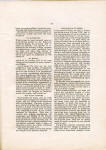 |
| |
eur060 |
tract. "Poor boy," our
friend Sluder calls it, and says he don't see what right
the girls have to style themselves
so, but they do all the same.
To give you an idea, last
night we accompanied a young lady to the hippodrome, and
although we had secured our seats beforehand,
the pretty girl who showed us to them deliberately demanded "a pour
hoire"
and much to our confusion, we
had after a pretended search in our
empty pocket, to borrow a
franc from our companion, otherwise the French damsel would have stood
by us all night, and have made our lives a torment, as only
ladies know how to do. Good bye.
paris,
August 30, 1889.
Dear Citizen :— To-day was devoted
to
working up the Exposition, so far as
this could be done in five hours' steady
walking. The conclusion arrived at by
your correspondent is that these shows
are tiresomely monotonous, and if one is
attempted for America in 1892, let it be
done on some new and more interesting
plan.
We
yet think that in very many respects
this is not equal to that in Philadelphia. In the beauty of the
grounds there
can be no comparison. Ours was far superior,
and the acres of cottons and silks,
and bottles of wine and cakes of soap,
and
machines and feather work, and all
that kind of thing are
just the same as we have seen over
and over again. So we suggest
once more that Congress immediately
appoint a commission to invent
something better and fresher for
'92, and let it be located near
Washington, where ample space can be
found, and no lack of skill or money to make the place the most
attractive of the world.
Some one suggested that we should have an iron tower twice as high as
this,
but
surely we can have some nobler ambition
than merely to excel in constructing
an
absolutely useless building. Such, certainly,
the Eiffel Tower is; nothing but a
wonderful display of the skill of its designer,
productive of no good, and not
es|jecially ornamental. We have not
again been tempted to pay five francs to
ascend it, but have walked
around its base and obtained a very
fair idea of its marvelous
size. You can conceive somewhat
of this, when we say that our court
house could be placed under one of the
arches that support the
first floor, and its tower would lack much of reaching
the top of the arch.
One great deficiency here is the want of
uniformed officials. Much trouble is
caused and unnecessary fatigue for want
of
some one to give information. We
have not been able to find a single policeman.
No doubt they are here, but not in uniform that a stranger can
recognize ; and for the first time
since reaching the Continent
our questions have met with rude answers. So, straggling aimlessly
around, we may perhaps have lost
much that was good and well worth
seeing.
We
met a pleasant gentleman, an American,
in the Nicaraguan building, and
had
explained the plans of the proposed
canal, of which a large model occupies
most of the floor. In Mexico, too, we
saw a plan for crossing the isthmus very
similar to that of the
lamented Eads, in which we always took great interest;
while near by was a building which one
may describe as containing models of the
canals of Suez and Panama, which we
entered, anxious to know what M. De
Lesseps had to show for the latter. Suez was found all right, but
not a vestige of the great French
scheme for cutting asunder
the two American continents. This
seemed rather ominous for the speedy
completion of the Panama.
Another great objection we
make to the Exposition, is the great number of
worthless sideshows which are
permitted, greatly to the annoyance of the visitor,
while very little is done for his
comfort. Restaurants abound, it is true, in great
numbers, but none good, and at
enormous prices. We longed to-day for the nice Vienna roll, which we
first tasted in 1876.
The exposition of foreign countries, as
a
rule, is very poor indeed, and they appear
to have taken but slight interest in
the show. As an evidence of this, the
only thing worth seeing in the
Egyptian house is a model of an ancient temple,
provided by our countrymen, Thomas
Cook & Son.
In
the machinery department we note
many things worthy of admiration,
among them remarkable locomotives
from Belgium, surpassing in size and
|
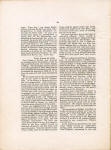 |
| |
eur061 |
weight any we ever saw, and of very different
construction to those of America.
The
absence of any cowcatcher gives
them a very snub-nosed look, but still
they are handsome.
The largest stationary engine, corresponding to the great Corliss, is
of French make, and carries a huge fly wheel, forty
feet in diameter, and five feet across the
face. Near this we noted a soap factory
in
operation, which surprised us no little,
as
from the trouble and expense which
we
have experienced, we did not suppose
that this luxury existed in France. Is it
not
strange, that these people who know
so
much of the refinements of life, should
refuse to provide such an essential to a
traveler as soap, and shut him up after dinner in a dark room with one
candle?
The idea that light is enjoyable does not
seem to enter their minds.
In
the French department we were much
interested in the mechanical toys, and
wished earnestly for all of our Buncombe
boys and girls to enjoy them with us.
And another thing which we are sure
they would like, is the aquarium. This
was curiously constructed under ground,
a
large circular passage, on each side of
which were reservoirs of water, into
which we could look with ease, as the
side next to us was of glass. In these reservoirs
thousands of fish of all sorts were
swimming about, in delight apparently
at
having so comfortable a home. In
one
compartment we could see hosts of bright gold fish, and adjoining them
beautiful shell fish of every imaginable
variety; even slimy eels, and hideous
crawfish and lobsters had
their place; while the passage in
which we walked was cool and
refreshing, and softly illuminated
by the rays of sunlight, which
were only allowed to reach it through
the water.
You
must know, too, that in these reservoirs
were all kinds of water plants, and
as
we looked up at them we fancied ourselves
with Jules Verne "twenty thousand
leagues under the sea."
We
fear we will not be able to visit the
exposition again, which we would like to do in hopes of forming a more
favorable opinion. It does not seem to be a financial
success, if one can judge from the
anxiety manifested by the bondholders
to
sell their ticket coupons. The streets
are filled with hawkers offering them at
half price. Pray gentlemen of Congress
let us do things better, if at all, in '92.
PARIS. August 31, 1889.
Dear Citizen:—To-day we will long remember as having been most
delightfully passed at the palace of Fontainbleau,
to reach which a ride of nearly fifty
miles by railway was required. Arriving
there at 11 o'clock we were obliged,
thanks to the abominable fashion of
France, to sacrifice an hour to secure a
much needed breakfast. But fortunately
this was done in a nice hotel, facing the
amphitheatre, with its famous old horseshoe
stairs, so that time was not entirely
wasted.
Breakfast being dispatched as quickly
as
possible, we hastened to this beautiful palace, a palace indeed, so rich
in history
from the time of Louis VII to that of the
last unfortunate emperor,
Louis Napoleon III.
It
may seem a trespass upon your space
and the patience of your readers to give
even the slight description, which we cannot
refrain from attempting, of some of
the principal apartments. If you so
consider it you need not publish it.
We will have the pleasure of writing it, all
the same.
We
were first conducted by the guide
into the chapel of the Holy Trinity, rather
small in size, and chiefly worthy of note
for
its beautifully frescoed ceiling, and tesselated marble floor, and as
the place
in
which the infant Napoleon III was
baptized.
We next ascended a stair
to enter the apartments of the great Napoleon, and
passing through three of moderate
size— one, the Salle de Bains,
now ornamented with glass
painted most curiously by some unknown artist, which used to be
in the bath room of Marie Antoinette,
and had been for some strange reason removed
hither—we enter the most deeply
interesting of these, to-wit, "La
Salle d' Abdication," in which
Bonaparte sat, and the table which supported the document that
must have cost him so much pain to
sign.
Adjoining this room is the "cabinet de
traveller [sic]," where the laborious man performed
such marvels of labor, and still
containing his desk, secretary, etc., and
|
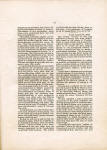 |
| |
eur062 |
from it we enter his bedchamber, in which
his bed stands, and near it the crib of his only son, the King of Rome.
Here also
are
the jewel box of Maria Therese and
a
strange clock given her by Pope Pius
VII.
We
next enter the Salle de Conseil, a
magnificent room containing a circular table nine feet in diameter, of
wood in color resembling mahogany, the whole
top
being of one solid piece. No doubt some of the big trees of California
may scorn this, but
we do not remember to have seen so
large and so perfect a specimen. Next is the Salle de Trone, containing
the throne of Napoleon, and with
ceiling inlaid with monograms of
Louis XIV, but attracting our attention to its
elegant chandelier which, we are
told, cost 50,000 francs.
We
now reach the suite of rooms especially
belonging to Marie Antoinette.
First, her boudoir, with
her chairs and sofas in old gold upholstering, and its floor laid in the
form of a star with the Queen's monogram in the center; second,
her bedchamber, containing her bed, of which the hangings surpass in
richness anything we have yet
seen. These, we are told,
were made in Lyons especially
for her, but her downfall occurred
before they were finished, so
they remained in the factory
until the time of Napoleon 1, who had them placed where they now
are; third, the salon of the unfortunate
Queen, in the center of which is her
lovely inlaid table, of which the mosaics
illustrate the four seasons, while
on the mantel are two vases
made for her by the Sevres factory, and the most perfectly
exquisite shade of blue we ever
imagined, much less beheld.
Among the most interesting rooms is
the library, filled with books and documents
of French history, ornamented
with paintings, but its
chief interest to us is the original
draft, in his own handwriting
of the Article of Abdication of Le
Petit Corporal. Its blurred and
scratched condition and many
interlineations seemed to
indicate the terrible mental
struggle it cost the writer. We could not
resist the temptation to copy it.
Here it is verbatim:
"Les puissances allies ayant proclaime
que l'Empereur Napoleon etait le seul obstacle
au retablissement de la Paix en
Europe, l'Empereur fidele at son sermons,
declare qu il renonce pour lui, et ses successeurs
au Trone de France et d'ltalie, et
qu il fidele a son sermons n' est ancun
sacrifice personnel meme celui de
la vie, qu il ne soit pres a faire au la bien interests
de la Nation France. 6 Avril, 1814."
To
this is no signature and; it differs in some respects from that which he
signed
next day, and we think its repetition and
inaccuracies indicate the
depth of the mental struggle.
Not to be too lengthy, the
other most remarkable rooms are the
salon of Francis I.; the
salon of Louis XIII in which that monarch was born; the salon of
Louis IX; "the saint," with an equestrian
statue of Henry IV over the mantle
; life size both man and horse which
will give an idea of the room's
dimensions ; boudoir and bed-room of Mme.
Maintenon, in which are chairs
curiously upholstered with
tapestried landscapes. It was in these rooms that this remarkable
woman ruled France through the weak
King Louis XIV. And yet we must;
note the magnificent gallery of
Henry II. This apartment is 100 by 40 feet, the
ceiling 30 feet high, wonderfully
formed in carved walnut
inlaid in gold, and each of its ornamentations are reproduced in
the oaken floor, so faithfully as to
lead one to imagine he sees,
them in a mirror.
Also deeply interesting are the apartments
of Pope Pius VII, which were occupied
by that pontiff first as the guest, and then as the prisoner of Napoleon
We will not bore you further with
details of these gorgeous,
royal rooms, although many others were of deep interest to us.
We hastened to see and enjoy the gardens
surrounding on three sides, the palace,
and the magnificent avenue which used to be its approach, and thence to
the court with which we will close this
letter, as here occurred the touching
scene on which we like to
ponder, sad though it be, yet showing the wonderful love,
which can exist between true men.
Here it was that the greatest of all chieftains
took leave of his faithful soldiers.
Our little French guide book
gives a description of this scene more pathetic than we have seen
elsewhere, and we must
attempt to give you even our poor translation of it:
"On
the morning of April 20, Napoleon
...
|
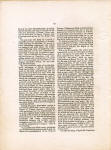 |
| |
eur063 |
... left Fontainebleau. He
wished to bid adieu to his guard, and
it had assembled in the court
of the White Horse, which has
since been called also "The Court of
the Adieus." "Soldiers," said he,
"my companions in arms, I
have always found you on the
road to honor; it is necessary
now that we part. I might have
remained longer with you, but it would
have been wicked to prolong a bitter
contention, attended perhaps by war
both civil and foreign, and I have
resolved to remain no longer
within the borders of France. May you enjoy the
best
you have so faithfully earned and be
happy. For myself, I make no
complaint. I have one mission
left, and it is for that I consent to live. That mission is to tell
posterity of the great things you and I
have together accomplished. Would
that I could take you each in
my arms, but let me embrace
this flag which represents you." Can we wonder that there
were few eyes dry, when the general
threw himself into his
carriage and was driven away
from his faithful guard ?
paris,
September 1, 1889.
Dear Citizen:—We do not
propose to occupy your space with
any detailed description of Versailles as we did of Fontainebleau,
although we have been in that magnificent palace most of to-day.
Nor can this be called much of a
Sabbath, for rest, we
have had none. On the contrary for hours we have been jostling
and tugging, and pushing and
squeezing, .and not cursing of
course, but being pursed most
heartily, as we wrestled with
a motley crowd of at least fifty
thousand men and women, each of whom were determined to be the very first
to get through the miles of rooms and
galleries, of which we have an impression on our
minds, mixed up of gold cornices and
frescoed ceiling, and French battles, and
statues and portraits, which are all
confused in an inextricable
jumble, so we can hardly hope to tell you what we
have seen; suffice it to say
everything is truly elegant,
especially the gallery of glass, which overlooks the gardens and
fountains, and in which the victorious
Germans announced their terms of
peace; hard indeed is this
for a poor Frenchman to
swallow.
Again, too, is Marie Antoinette brought
to mind, as we pass through her private
apartments and see the stairs by which
she attempted to escape from the mad
mob, but the one room that repaid all of
our frantic struggle and fatigue, is that
in
the center of which is a marble figure
of
the dying Napoleon similar but superior
to that in the Corcoran gallery;
while immediately above it is a large and
life-like painting of the great
Emperor as he delivered the
Eagles to his soldiers. So at
one glance, he stands before us, at the
highest point of his power, and the
zenith of his glory, and as
he sat in his despair, the
strong features and lips pressed together,
indicating the bitter thoughts
concealed behind that massive
forehead, even at this hour of
approaching dissolution.
It
did indeed seem an anomaly that
these gorgeously regal rooms should be
given up to the mob, which today filled
them, and to us royalty is the necessary
thing for France. We cannot believe that a republic can endure for a
people of their strange peculiarities.
Wearied and heart sick at viewing
these signs of departed glory, we are
glad to get out, into the fresh air of the
wonderful gardens and stroll through them to the Trianon, another
palace,
where we are shown several more of
Marie Antoinette's beds, (she must have
been a very sleepy body) and then to the
State carriages at which the crowd is so
dense that Sluder and I climb in at a
window and launch our bodies upon the
mass of French humanity, which is
squirming below us. Much cursed and abused, but minded it little, we
thus
succeed in viewing these gorgeous relics
of
former ages.
Six of these carriages, each with a history
of its own, surrounded the grandest
of
all, which was the coronation coach
of
Charles X. It is a huge affair, covered
with gold from end to end, the very
wheels a mass of gilding richly wrought,
while on top are groups of statuettes of
some metal. Neither of us regretted the
effort we had made to catch even a hasty
glance at these old coaches.
The
event of the day to us was yet to
occur, and this was our excuse for devoting
Sunday to these excursions, as only on
this holy day are the fountains allowed
to
play, or as these people say, "Les eaux ... |
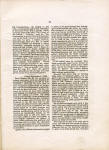 |
| |
eur064 |
...
ses marchent,"
literally "the waters walk
themselves," and this is
attended with such great expense that it is done for only one hour.
Beginning at 5 o'clock they suddenly burst forth in wreaths of spray,
surpassing the most delicate lace, which the setting sun embellishes
with innumerable arcs of prismatic coloring.
A description is far beyond us; in
number they are infinite, in variety endless, in beauty each
seems more exquisite than the last. Around and around we walk in
delight. Let those who wish take pleasure in high art; we prefer these
jets of pure water, surrounded with
the fragrance of sweet
flowers.
The
last of these fountains, that of Neptune, was reserved until the others were
done, to allow the visitors to collect
around it. Indeed, 'twas a
wonderful sight. In the form of an irregular crescent
is a pond of still water, in which thousands
of carp are lazily swimming, this pond is in area about two
acres; the distance from point to point of the crescent
some 800 feet; around its convex a
solid mass of people facing the smaller circle, which is built of
heavily grained stone, rising seven feet above the water's edge, while
at the center is placed a massive bronze Neptune in his chariot drawn by
six sea lions, and supported on
right and left by groups of
mermaids. Midway on each side from center to apex is a group
composed of immense nautical fabulous
animals, and at each extreme point a
dolphin of some material and
of huge dimensions. On top
of the wall are twenty-six vases, each ten feet in height, and on
its face a corresponding number of human
heads.
Suddenly the grand old sea god belches forth from mouth and nostrils his
element
in
foam and mist, which gives the signal
to his satellites, and
each promptly responds and tries to
excel his chief. From our
position we counted 100 jets extending from point to point, some
perpendicular, others gracefully curving over the lake, and
above all a lovely rainbow—a suitable completion to this truly fairy
scene.
A glance backward over
these notes really shocks us with the thought of our temerity in
attempting this description. We really did not intend it, but were so
full of our subject that we have written
on and on, almost unconsciously. And
how faint an idea you will have of the
reality!
Although the shades of night are rapidly
approaching, and we are many miles
from our pension, the temptation to linger
overcomes our prudence, and once
more we ascend the gentle
slope to the grand terrace in front of the palace and take our stand
near Latona's Fountain, now still and
quiet, where a few minutes
ago the goddess was protecting her two
children, Apollo and Diana, from
being submerged, and here we
take one long, lingering
look, the last perchance for us, at
this noble pile. The whole building
stands before us, in length
nearly 4,000 feet, but its immensity is the last consideration,
and the least; its architectural beauty is
divine, but the surroundings are the
chief attraction; and still we linger through
the twilight, wandering up and down
the lovely vistas. Even at this late moment
we discover a new charm, which rivets
us to the spot until there is no longer
light for its contemplation.
This, in a sequestered nook which until
now we had not discovered, is a huge
mass of rough rock, artificial, some sixty
feet high, and indented deeply with grottoes,
from which seem to emerge Apollo
attended by his nymphs, some of whom
are presenting him with food, while others
are supplying his steeds with water
dipped in shells from the crystal lake at
their feet. These groups are all of
pure white marble, contrasting
beautifully with the
dark stone background.
You cannot wonder that we found it
hard to tear ourselves away. At
night we left and took our train again for
Paris, which in due time we reached, convinced
that seldom have we passed a
more delightful Sunday. While not spent
in
a manner altogether orthodox, we do
hope it has not been utterly unprofitable.
We
have seen things calculated to exalt
our
ideas of man's capabilities; we have
seen marvels of human intellect and
science, and to us the lesson still is, how
infinitely greater is He
who created the men who produced
these works, and yet how wonderful His kindness, that He condescends to
allow us, weak creatures that we are, to call Him "Our Father." |
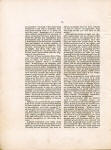 |
| |
|
|
|